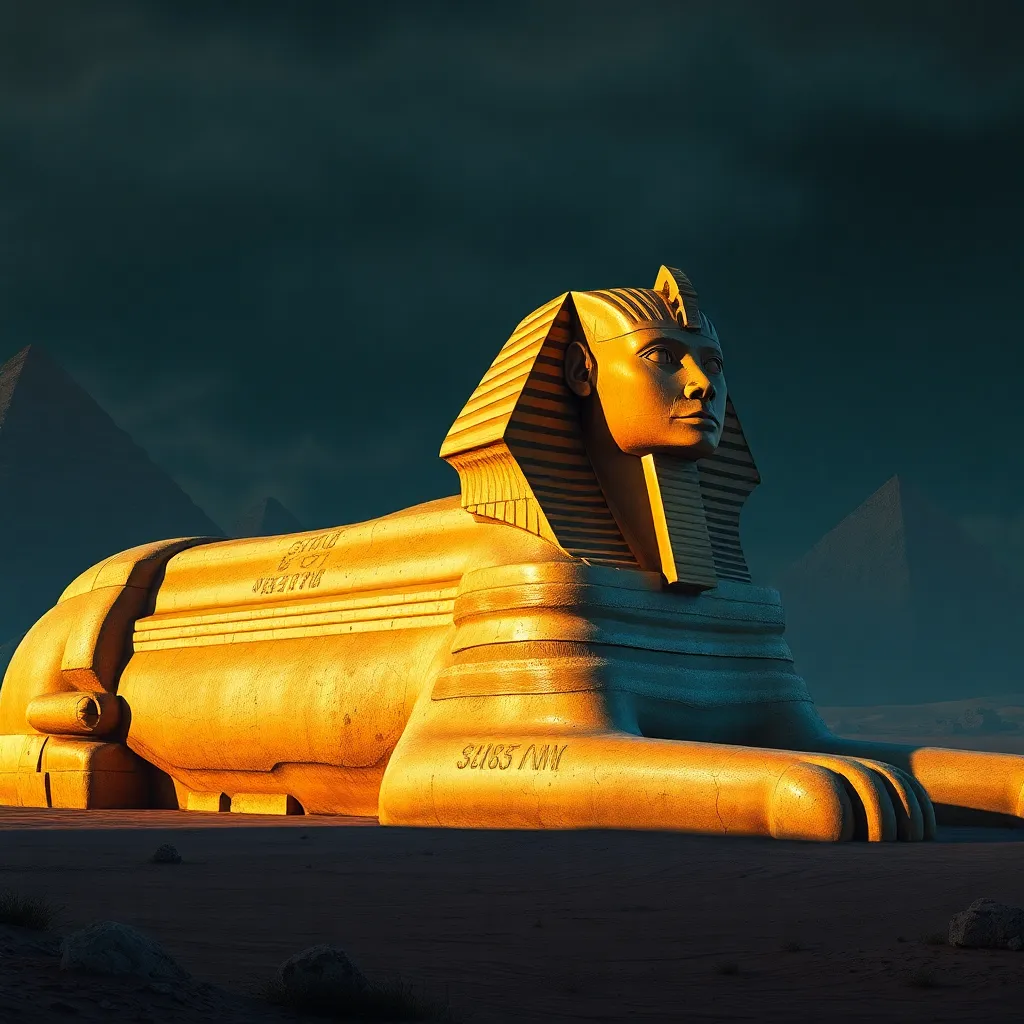The Sphinx and Its Connection to the Underworld
I. Introduction
The Great Sphinx of Giza is one of the most iconic symbols of Ancient Egypt, representing a unique blend of human and animal characteristics. This monumental statue, with the body of a lion and the head of a pharaoh, is not only an architectural marvel but also a profound emblem of ancient Egyptian culture. The Sphinx’s significance extends beyond mere aesthetics; it is steeped in mythology and symbolism, particularly concerning its association with the Underworld.
In ancient Egyptian belief, the Underworld, known as Duat, was a crucial aspect of the afterlife. It was viewed as a realm where the soul would journey after death, facing trials and judgments. This connection between the Sphinx and the Underworld reveals much about the Egyptians’ understanding of life, death, and the cosmos.
II. The Historical Context of the Sphinx
The Great Sphinx of Giza is believed to have been constructed during the reign of Pharaoh Khafre around 2500 BC. It stands as a sentinel near the Great Pyramids, symbolizing the pharaoh’s divine authority and the protective power of the gods. The Sphinx, carved from limestone, measures about 73 meters (240 feet) long and 20 meters (66 feet) high, making it one of the largest monolithic statues in the world.
In relation to the Pyramids, the Sphinx is positioned along the Giza plateau, aligning with the celestial bodies and serving as a guardian of the tombs of the pharaohs. Its placement in the landscape of ancient Egypt signifies its importance as a protective force, safeguarding the passage to the afterlife.
III. Symbolism of the Sphinx
The Sphinx embodies a dual nature, representing both human intelligence and the strength of the lion. This combination symbolizes a balance of power, wisdom, and protection. The lion’s body signifies strength and courage, while the human head represents intellect and divine authority.
- Power: The Sphinx stands as a symbol of the pharaoh’s power and his connection to the divine.
- Protection: It served as a guardian of sacred spaces, especially burial sites.
- Guardianship: The Sphinx is often thought to protect the realm of the dead from chaos and disorder.
This duality also reflects the ancient Egyptians’ beliefs about life and death, emphasizing that both realms are interconnected. The Sphinx thus serves as a bridge between the mortal and the divine, embodying the complexities of existence.
IV. The Underworld in Ancient Egyptian Beliefs
In ancient Egyptian cosmology, the Underworld was a mysterious and sometimes perilous realm where souls journeyed after death. The Egyptians believed in a cyclical nature of life, death, and rebirth, with the Underworld playing a vital role in this process.
Key figures associated with the Underworld include:
- Osiris: The god of the afterlife, responsible for judging the souls of the deceased.
- Anubis: The god of mummification and the protector of graves, guiding souls to the afterlife.
- Ma’at: The goddess of truth and justice, whose principles governed the judgment process.
The journey of the soul involved navigating various challenges, culminating in the weighing of the heart against the feather of Ma’at. Success in this judgment allowed the soul to enter the Fields of Aaru, a paradisiacal realm, while failure led to annihilation.
V. The Sphinx as a Guardian of the Underworld
The Sphinx’s role in protecting sacred spaces is well-documented in ancient texts and archaeological findings. It was believed that the Sphinx safeguarded the tombs of pharaohs and acted as a sentinel against malevolent forces.
Myths and legends often depict the Sphinx as a formidable guardian, challenging those who sought to enter sacred areas without proper respect or knowledge. Its fierce presence served to deter intruders and maintain the sanctity of the afterlife.
Artistic depictions of the Sphinx can be found in various tombs and temples, showcasing its significance in funerary practices. These images often illustrate the Sphinx in association with deities, reinforcing its protective role within the spiritual landscape of ancient Egypt.
VI. Archaeological Discoveries Related to the Sphinx and the Underworld
Significant archaeological findings at the Giza plateau have shed light on the relationship between the Sphinx and the Underworld. Excavations have uncovered artifacts that suggest the Sphinx was part of a larger funerary complex, indicating its importance in burial practices.
Interpretations of these artifacts point to the Sphinx’s role in rituals aimed at ensuring safe passage to the afterlife. Furthermore, ongoing research continues to reveal new insights into the cultural and religious significance of the Sphinx, as well as its connection to ancient Egyptian beliefs about death and resurrection.
VII. Modern Interpretations and Cultural Impact
The Sphinx has transcended its ancient origins, becoming a symbol of mystery and intrigue in contemporary literature and media. From novels to films, the Sphinx is often portrayed as a timeless enigma, representing the allure of ancient wisdom and the unknown.
In modern understandings of ancient Egyptian religion, the Sphinx is recognized as a vital figure that embodies the complexities of life, death, and the afterlife. Its legacy continues to influence modern spirituality and mysticism, with many viewing it as a symbol of protection and enlightenment.
VIII. Conclusion
In summary, the Sphinx’s significance as a symbol of the Underworld is profound and multifaceted. Its dual nature and protective role highlight the intricate beliefs of the ancient Egyptians regarding life and death. The enduring legacy of the Sphinx, both in ancient and modern contexts, serves as a testament to the rich cultural tapestry of Egyptian mythology.
Understanding the Sphinx and its connections to the Underworld enriches our appreciation of ancient Egyptian civilization and its complex worldview. As we continue to explore these cultural symbols, we gain valuable insights into the historical frameworks that shaped human thought and belief.




